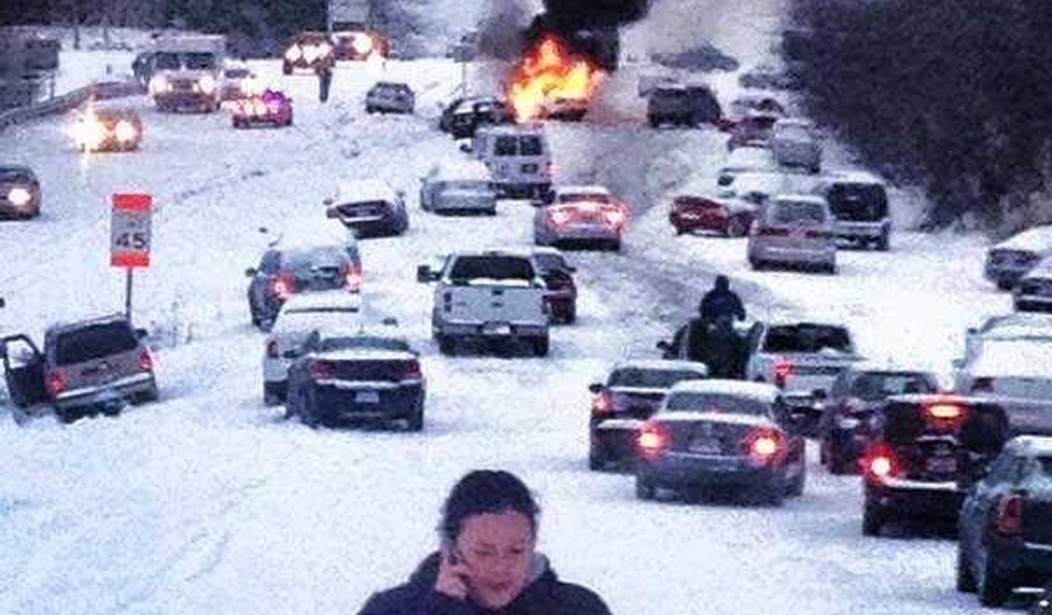WASHINGTON – As a snowstorm prepared to blanket the nation’s capital, a Department of Homeland Security (DHS) official told the Senate on Wednesday that extreme weather comes with a sizable price tag and the trend is likely to continue unless state and local governments improve efforts to prepare for natural disasters.
The Senate Homeland Security and Governmental Affairs Committee hearing came just weeks after a surprise snowstorm paralyzed Atlanta and just hours before Congress recessed and got out of town before a foot or more of snow moved in.
In his opening statement, the committee’s chairman, Sen. Tom Carper (D-Del.), said that extreme weather events seem to be the “new norm.”
“Events like Superstorm Sandy, which came to our shores in the mid-Atlantic a year or so ago, and recent wildfires in other parts of the country, dangerous tornadoes, historic droughts — it may well be just the tip of the iceberg of what’s to come. And even today, the East Coast is preparing for yet another snowstorm, while the West Coast is experiencing a historic drought and increased fire danger with no end in sight.”
Carper sought to avoid a discussion of climate change, saying the hearing was not intended to “hash out climate science,” but rather to find common ground on the costs – both economic and lives affected – of not being prepared for extreme weather.
“For years, I’ve been working with a number of our colleagues to address the root causes and unfolding effects of what I believe is one of the biggest challenges of our generation: climate change,” Carper said. “According to the U.S. global change research program, extreme weather events have increased in frequency over the last 50 years or so and are expected to become even more common, more intense and more costly.”
David Heyman, assistant secretary for policy at DHS, said the economic losses sustained in the U.S. in the past 30 years totaled $1.15 trillion.
In 2011, there were 98 presidentially declared disasters and the U.S. experienced 14 natural disasters, exceeding a billion dollars in cost each, a record number in both cases.
“Without a concerted effort – national resilience effort, the trend is likely to continue,” he warned.
Heyman said that investing in resilience efforts in both new and old structures is very important, citing a study by the Multi-Hazard Mitigation Council that determined for every dollar the U.S. government spent on mitigation, it saved an average four dollars post-disaster.
States like Delaware have invested in improving storm resilience and the investment has paid off, according to state officials.
Collin O’Mara, secretary of the Delaware Department of Natural Resources, said that for every dollar his state has invested in shore protection it has received $10 in storm protection value.
O’Mara said states that support storm preparation are suffering when the federal government assists ill-prepared communities that have failed to invest in storm preparation.
“We need to stop rewarding communities that fail to prepare. Right now, a state like Delaware that’s spent a lot of state and local money doesn’t receive as much after a disaster because our systems work,” O’Mara said.
Heyman said DHS is starting a pilot program called Resilience STAR based on the Energy STAR program that would set voluntary standards for building and disaster preparedness that will help communities respond to disasters much more quickly.
 Mark Gaffigan, the managing director for the U.S. Government Accountability Office’s National Resources Environmental Team, said the financial risks from two federal insurance programs create a “significant fiscal exposure.” He said there are four areas where the government could limit this exposure: disaster aid, infrastructure ownership, property and crop insurance, and providing technical assistance to state and local governments.
Mark Gaffigan, the managing director for the U.S. Government Accountability Office’s National Resources Environmental Team, said the financial risks from two federal insurance programs create a “significant fiscal exposure.” He said there are four areas where the government could limit this exposure: disaster aid, infrastructure ownership, property and crop insurance, and providing technical assistance to state and local governments.
Gaffigan noted that the annual costs to run the federal government’s crop insurance program have more than doubled, and the flood insurance program has a $24 billion debt. In 2012, the federal flood insurance program had property coverage of over $1.2 trillion, and the crop insurance program covered $120 billion in crops, a four-fold increase in the crop insurance program since 2003.
Gaffigan said the federal government should start fully budgeting for the costs associated with weather events, which often come from outside the normal budgeting process. In addition to finding ways to addresses the risks, he also advised the federal government to improve access for state and local governments to the best available climate-related information.
“Taxpayers are bearing the burden of this increasingly unbudgeted risk and associated loss costs,” said Lindene Patton, chief climate product officer for Zurich Financial Services.
Patton said the U.S. is increasingly reliant on disaster recovery funding to respond to extreme weather events, and is underinvested in resilience.
A 2010 paper by J. David Cummins concluded that the federal government’s share of unfunded disaster response costs for weather-related disasters could grow to between $1.2 trillion and $5.7 trillion over the next 75 years.
“From a practical perspective, funding resilience is a fundamentally wiser investment than spending on disaster relief and recovery,” Patton said.
A Business Continuity Institute study found that 40 percent of businesses affected by extended periods of severe weather never recovered or reopened. The same study found that extreme weather is the cause of 45 percent of supply chain disruptions.
Without risk reduction action by government and insurers, the unbudgeted disaster management costs can be expected to continue on an upward trajectory, she said.
Patton said one way for Congress to improve resilience is by expanding the Resilience STAR pilot program.
Caitlin Durkovich, assistant secretary for infrastructure protection at DHS, said extreme weather disrupts the security of the nation by diverting attention from counterterrorism efforts and straining the government’s resources.
“To achieve infrastructure resilience, owners and operators must be able to minimize the disruption to essential services provided to our communities,” Durkovich said. “And when a disruption occurs, ensure essential services and functions are brought back to full operations as quickly as possible.”









Join the conversation as a VIP Member